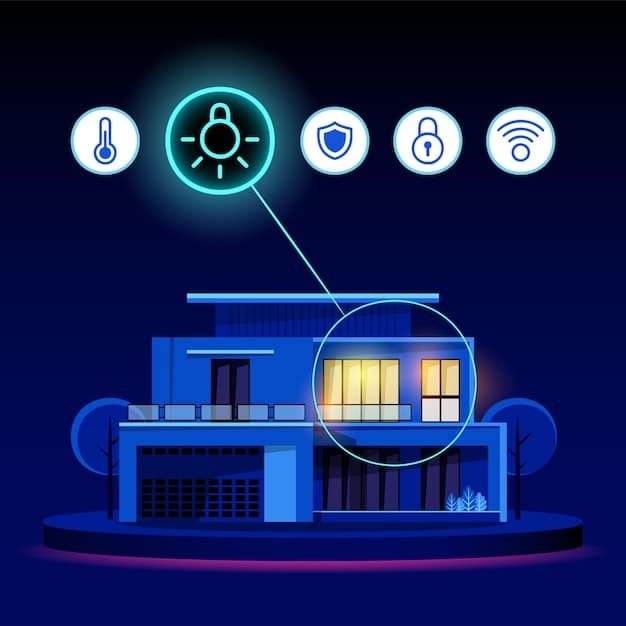Smart Home Security: 5 Unexpected Data Protection Methods for 2025

Smart home security in 2025 extends beyond traditional measures, requiring innovative approaches to protect data privacy through secure device configurations, robust network segmentation, proactive firmware management, AI-driven threat detection, and privacy-focused device selection.
The evolving landscape of smart home technology brings convenience and connectivity, but also introduces new vulnerabilities. Securing your smart home security in 2025 requires more than just a strong password; it demands a proactive and innovative approach to data protection.
Beyond the Basics: Smart Home Security in 2025
As smart homes become increasingly integrated into our daily lives, the amount of personal data they collect and transmit grows exponentially. This data, ranging from our daily routines to our communication patterns, becomes a valuable target for cybercriminals. Therefore, it’s crucial to go beyond the conventional security measures.
In this section, we’ll discuss the limitations of traditional security approaches and why a more comprehensive strategy is necessary for 2025. This includes understanding the potential risks unique to smart home ecosystems and adopting new methods for safeguarding your sensitive information.
The Rising Stakes of Smart Home Data Security
The interconnected nature of smart devices means that a single vulnerability can compromise the entire network. Consider the following:
- Increased Attack Surface: More devices translate to more entry points for attackers.
- Data Aggregation: Smart homes collect a wide array of data, creating a detailed profile of your lifestyle.
- Privacy Implications: Data breaches can expose personal information, leading to identity theft and other forms of fraud.
Addressing these challenges requires a shift in mindset from reactive to proactive security measures.

Securing a smart home in 2025 isn’t just about installing antivirus software; it involves understanding the nuances of data flow within the home and implementing strategies to minimize risks. It’s about creating a digital fortress that adapts to the ever-changing threat landscape.
1. Secure Device Configuration: Hardening Your Smart Home Ecosystem
Often overlooked, the initial setup and configuration of your smart devices can significantly impact your overall security posture. Default settings are rarely optimized for security, making them easy targets for exploitation.
This section discusses how to properly configure your smart devices, emphasizing the importance of changing default passwords, disabling unnecessary features, and understanding the privacy settings available on each device.
Strengthening Device Defenses
Here are critical steps to take when setting up your smart devices:
- Change Default Passwords: Always replace the factory-set password with a strong, unique one.
- Disable UPnP: Universal Plug and Play can create security vulnerabilities. Disable it unless absolutely necessary.
- Enable Two-Factor Authentication (2FA): Add an extra layer of security to your accounts.
Proper device configuration isn’t a one-time task; it’s an ongoing process that requires regular review and adjustment as new threats emerge.
By taking the time to properly configure your smart devices, you can significantly reduce the risk of compromise and protect your sensitive data. It’s like locking the doors and windows of your digital home.
2. Network Segmentation: Isolating Your Smart Devices
Network segmentation involves dividing your home network into separate zones, each with its own security protocols. This approach prevents an attacker from gaining access to your entire network if one device is compromised.
We will explore how to create separate networks for different types of devices, such as a dedicated network for IoT devices, a network for personal computers, and a guest network for visitors. Network segmentation minimizes the impact of a potential breach and enhances overall security.
Implementing Network Zones
Network segmentation can be achieved through various methods:
- Guest Network: Provide internet access for visitors without granting access to your main network.
- IoT Network: Isolate smart home devices on a separate network to limit their access to sensitive data.
- VLANs: Virtual LANs can segment your network even further, providing granular control over network traffic.
By segmenting your network, you create a series of firewalls that prevent unauthorized access to critical resources. It’s like having multiple layers of security in your home.
Network segmentation is a crucial step in enhancing smart home security. It provides an additional layer of defense against potential threats and limits the damage caused by a successful attack.

3. Proactive Firmware Management: Keeping Your Devices Updated
Firmware updates often include critical security patches that address newly discovered vulnerabilities. Failing to install these updates leaves your devices exposed to known exploits. Many users ignore the importance of these updates, leaving their devices vulnerable. This section will cover the importance of proactive firmware management and how to automate the update process.
Learn how to enable automatic updates on your smart devices, create a schedule for manual updates, and verify the authenticity of firmware before installation.
The Importance of Keeping Software Current
Firmware updates are essential for maintaining a secure smart home:
- Security Patches: Updates often address known vulnerabilities that attackers can exploit.
- Performance Improvements: Firmware updates can enhance device performance and stability.
- New Features: Updates may include new features and capabilities that improve your smart home experience.
Regularly updating firmware is akin to maintaining the structural integrity of your home. By keeping your devices current, you reinforce their defenses against evolving threats.
Proactive firmware management is a critical aspect of smart home security. By automating the update process and staying informed about the latest security patches, you can minimize the risk of exploitation and protect your data.
4. AI-Driven Threat Detection: Employing Smart Security Solutions
Artificial intelligence (AI) is revolutionizing the field of cybersecurity, offering sophisticated threat detection capabilities that can proactively identify and mitigate potential risks. AI-driven security solutions can analyze network traffic, user behavior, and device activity to detect anomalies that may indicate a security breach.
This section will discuss how to leverage AI-powered security solutions to enhance smart home security, including intrusion detection systems, behavioral analysis tools, and predictive threat modeling.
AI as a Security Shield
AI-driven threat detection offers several advantages:
- Real-Time Monitoring: AI systems can monitor your network 24/7, detecting threats as they emerge.
- Behavioral Analysis: AI can learn your normal network behavior and identify anomalies that may indicate a breach.
- Automated Response: AI can automatically respond to threats, isolating compromised devices and preventing them from spreading.
By using AI-driven threat detection, you gain a powerful security tool that can proactively identify and mitigate potential risks. It’s like having a security guard who never sleeps.
AI-driven threat detection is a game-changer in smart home security. By leveraging the power of artificial intelligence, you can protect your home from evolving cyber threats and enjoy a more secure smart home experience. It’s the next step in proactive security for the modern home.
5. Privacy-Focused Device Selection: Choosing Security-Conscious Brands
The security and privacy of your smart home depend largely on the devices you choose. Some manufacturers prioritize security and privacy, while others focus solely on functionality and convenience. This section covers the importance of selecting privacy-focused devices and brands that have a proven track record of protecting user data.
Making Informed Choices
When selecting smart home devices, consider the following factors:
- Reputation: Research the manufacturer’s reputation for security and privacy.
- Privacy Policies: Review the device’s privacy policy to understand how your data is collected and used.
- Security Features: Look for devices with built-in security features, such as encryption and two-factor authentication.
Choosing privacy-focused devices is an investment in your security. It ensures that your data is handled responsibly and protected from unauthorized access.
Selecting privacy-conscious brands is just as important as implementing security measures. By making informed choices, you can create a smart home environment that respects your privacy and safeguards your data. It’s about putting security first when building your smart home ecosystem.
| Key Point | Brief Description |
|---|---|
| 🔑 Secure Configuration | Change default passwords, disable UPnP, enable 2FA. |
| 🛡️ Network Segmentation | Isolate devices using guest networks, IoT networks, or VLANs. |
| 🔄 Firmware Updates | Enable automatic updates or create a manual update schedule. |
| 🤖 AI Threat Detection | Use AI for real-time monitoring and automated responses. |
Frequently Asked Questions
▼
Smart home security is crucial because these devices collect personal data, making them targets for cyber threats. Compromised devices can expose sensitive information and compromise your privacy.
▼
You should update your smart device firmware as soon as updates become available. These updates often include critical security patches that protect against known vulnerabilities.
▼
Network segmentation divides your home network into separate zones, isolating devices. This prevents attackers from accessing your entire network if one device is compromised, enhancing security.
▼
AI enhances security by monitoring network traffic, user behavior, and device activity to detect anomalies. It can proactively identify and mitigate potential risks in real-time.
▼
Privacy-focused devices are designed with user data protection in mind. Choosing reputable brands ensures your personal information is handled responsibly and protected from unauthorized access.
Conclusion
Securing your smart home in 2025 requires a multi-faceted approach that goes beyond traditional security measures. By implementing secure device configurations, network segmentation, proactive firmware management, AI-driven threat detection, and privacy-focused device selection, you can significantly enhance your data protection and enjoy a safer, more secure smart home experience. Stay vigilant and adapt your security practices as technology evolves to safeguard your digital life effectively.





